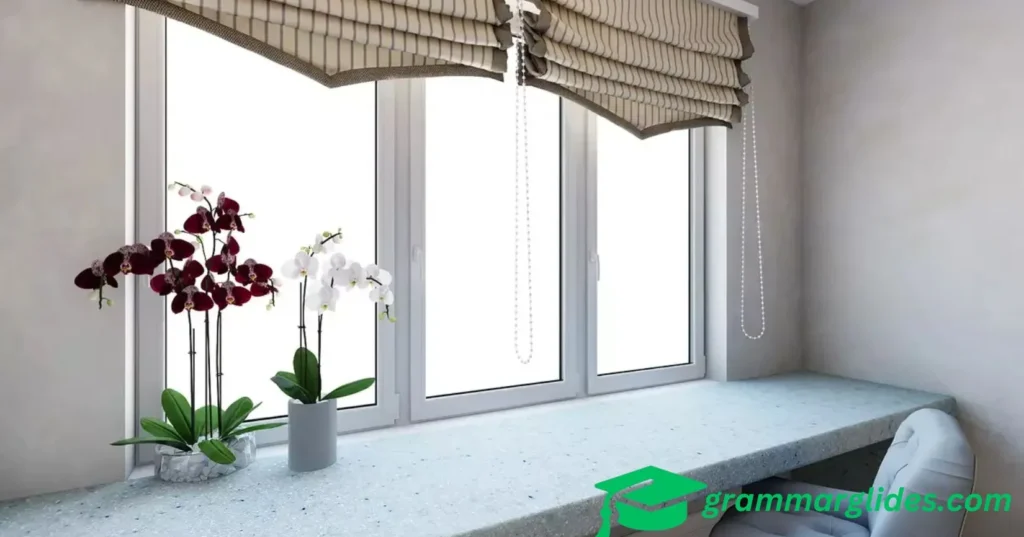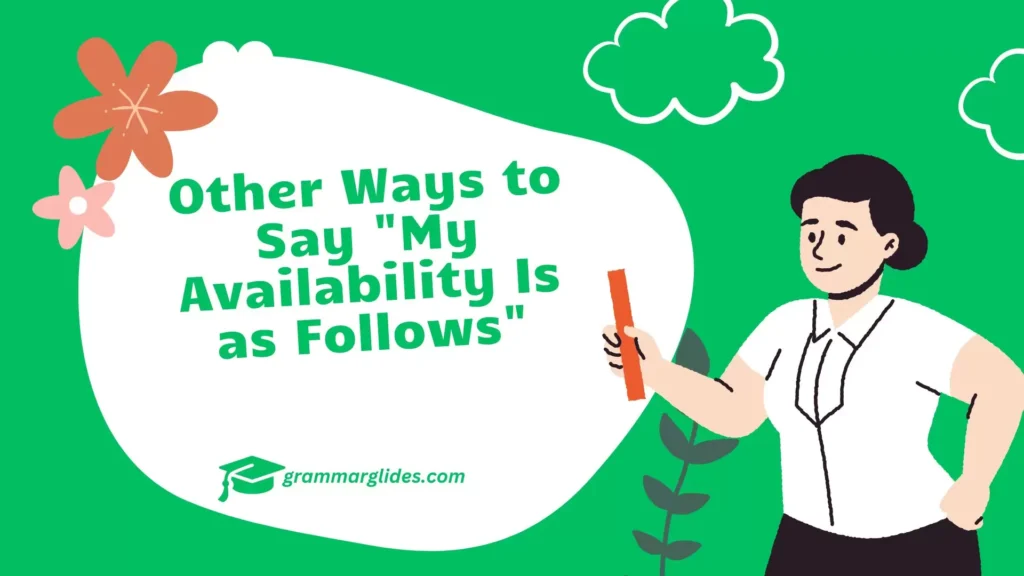“Check my availability for seamless scheduling.”
When you’re trying to coordinate schedules, it’s essential to communicate your availability clearly and professionally. Whether you’re setting up a meeting, arranging a call, or planning an event, having a variety of phrases at your disposal can make the process smoother and more personable.
In this article, we’ll explore different ways to say “My availability is as follows,” complete with examples and explanations to help you choose the right phrase for any situation.
1. Here’s When I’m Free

Scenario: You’re scheduling a meeting with a colleague.
Example 1: “Here’s when I’m free: Monday at 3 PM, Tuesday at 10 AM, and Thursday at 2 PM.” Example 2: “Here’s when I’m free next week: Wednesday at 11 AM or Friday at 9 AM.”
Explanation: “Here’s when I’m free” is a straightforward and casual way to communicate your availability. It’s concise and keeps the conversation focused on finding a suitable time to meet.
2. I’m Available During These Times

Scenario: You’re arranging a call with a client.
Example 1: “I’m available during these times: Tuesday from 1 PM to 4 PM, and Wednesday from 9 AM to 11 AM.”
Example 2: “I’m available during these times next week: Monday afternoon or Thursday morning.”
Explanation: “I’m available during these times” is a polite and professional way to present your availability. It clearly outlines the time slots you can commit to, making it easier for the other party to choose a convenient time.
3. The Times That Work for Me Are

Scenario: You’re coordinating a project meeting with your team.
Example 1: “The times that work for me are Tuesday at 2 PM and Thursday at 10 AM.”
Example 2: “The times that work for me are Monday at 3 PM or Wednesday morning.”
Explanation: “The times that work for me are” is a collaborative way to suggest meeting times. It emphasizes your flexibility while providing specific options, making it easier for others to agree on a time.
4. My Open Slots Are
Scenario: You’re setting up a consultation with a new client.
Example 1: “My open slots are Wednesday afternoon and Friday morning.”
Example 2: “My open slots next week are Tuesday at 9 AM or Thursday at 1 PM.”
Explanation: “My open slots are” is a casual yet clear way to list your available times. It works well in informal or semi-formal settings and allows the other person to see your availability at a glance.
5. I’m Free At the Following Times

Scenario: You’re planning a discussion with a colleague.
Example 1: “I’m free at the following times: Monday at 10 AM, Wednesday at 2 PM, and Friday at 11 AM.”
Example 2: “I’m free at the following times next week: Tuesday at 3 PM or Thursday at 9 AM.”
Explanation: “I’m free at the following times” is a simple and direct way to communicate your availability. It’s ideal for situations where you want to be clear and unambiguous about when you can meet.
6. These Times Work for Me
Scenario: You’re organizing a meeting with your team.
Example 1: “These times work for me: Monday at 11 AM and Thursday at 3 PM.”
Example 2: “These times work for me next week: Wednesday morning or Friday afternoon.”
Explanation: “These times work for me” is a collaborative phrase that suggests flexibility while offering specific options. It’s a friendly and cooperative way to align schedules.
7. Available Time Slots Include

Scenario: You’re coordinating with a business partner.
Example 1: “Available time slots include Tuesday at 1 PM and Thursday at 10 AM.”
Example 2: “Available time slots include Monday afternoon or Wednesday morning.”
Explanation: “Available time slots include” is a formal and professional way to list your availability. It’s suitable for business communications where clarity and professionalism are key.
8. I Can Meet at These Times
Scenario: You’re arranging a catch-up with a friend.
Example 1: “I can meet at these times: Monday at 3 PM or Wednesday at 5 PM.”
Example 2: “I can meet at these times next week: Thursday afternoon or Friday morning.”
Explanation: “I can meet at these times” is a casual and friendly way to suggest meeting times. It’s perfect for informal settings where you want to keep the tone light and flexible.
9. I’m Free During the Following Hours

Scenario: You’re planning a conference call with a remote team.
Example 1: “I’m free during the following hours: Tuesday from 10 AM to 12 PM, and Thursday from 2 PM to 4 PM.”
Example 2: “I’m free during the following hours next week: Monday morning or Friday afternoon.”
Explanation: “I’m free during the following hours” is a precise way to communicate your availability. It’s particularly useful when you need to block out larger chunks of time for meetings or calls.
10. My Schedule Is Open At
Scenario: You’re trying to set up an interview with a potential candidate.
Example 1: “My schedule is open at 2 PM on Tuesday and 10 AM on Thursday.”
Example 2: “My schedule is open at 11 AM on Monday or 3 PM on Wednesday.”
Explanation: “My schedule is open at” is a professional and clear way to indicate when you’re available. It’s ideal for formal communications, such as interviews or business meetings.
11. I’m Free on These Days

Scenario: You’re planning a meeting with a colleague from another department.
Example 1: “I’m free on these days: Monday, Wednesday, and Friday.”
Example 2: “I’m free on these days next week: Tuesday and Thursday.”
Explanation: “I’m free on these days” is a straightforward way to communicate your availability. It’s perfect for situations where you need to provide multiple options over several days.
12. Here Are My Available Times
Scenario: You’re scheduling a follow-up meeting with a client.
Example 1: “Here are my available times: Monday at 9 AM, Tuesday at 1 PM, and Thursday at 3 PM.”
Example 2: “Here are my available times next week: Wednesday morning or Friday afternoon.”
Explanation: “Here are my available times” is a polite and professional way to present your schedule. It offers flexibility while being clear about when you can meet.
Other Ways to Say “Thank You for Everything”
13. I’m Open At These Times

Scenario: You’re arranging a brainstorming session with your team.
Example 1: “I’m open at these times: Tuesday at 10 AM and Thursday at 2 PM.” Example 2: “I’m open at these times next week: Monday at 11 AM or Friday at 3 PM.”
Explanation: “I’m open at these times” is a collaborative phrase that suggests you’re ready to meet during the specified slots. It’s ideal for team settings where cooperation is key.
14. My Free Time Includes
Scenario: You’re coordinating with a freelancer on a project.
Example 1: “My free time includes Monday afternoon and Wednesday morning.”
Example 2: “My free time includes Tuesday at 3 PM and Thursday at 10 AM.”
Explanation: “My free time includes” is a casual and flexible way to suggest when you can meet. It’s perfect for less formal settings where you want to keep the conversation open.
15. I Can Do These Times

Scenario: You’re scheduling a check-in with your manager.
Example 1: “I can do these times: Monday at 2 PM or Wednesday at 10 AM.”
Example 2: “I can do these times next week: Thursday morning or Friday afternoon.”
Explanation: “I can do these times” is a straightforward and clear way to communicate your availability. It’s ideal for situations where you want to be direct and to the point.
16. I’m Open for These Times
Scenario: You’re arranging a lunch meeting with a colleague.
Example 1: “I’m open for these times: Tuesday at 12 PM or Thursday at 1 PM.”
Example 2: “I’m open for these times next week: Monday at 11 AM or Friday at 12 PM.”
Explanation: “I’m open for these times” is a friendly and flexible way to suggest meeting slots. It’s perfect for informal meetings or casual get-togethers.
17. My Available Windows Are

Scenario: You’re coordinating with an external partner.
Example 1: “My available windows are Monday at 10 AM and Wednesday at 3 PM.”
Example 2: “My available windows are Tuesday afternoon and Thursday morning.”
Explanation: “My available windows are” is a more formal way to indicate your availability. It’s suitable for professional settings where clarity and precision are important.
18. I’m Free At These Intervals
Scenario: You’re planning a series of meetings for a project.
Example 1: “I’m free at these intervals: Monday from 9 AM to 11 AM, and Wednesday from 2 PM to 4 PM.”
Example 2: “I’m free at these intervals next week: Tuesday morning or Thursday afternoon.”
Explanation: “I’m free at these intervals” is a detailed way to present your availability. It’s useful when you need to communicate specific time slots over several days.
19. The Best Times for Me Are

Scenario: You’re arranging a call with a new client.
Example 1: “The best times for me are Tuesday at 1 PM and Thursday at 3 PM.”
Example 2: “The best times for me are Monday morning or Wednesday afternoon.”
Explanation: “The best times for me are” is a polite and professional way to suggest meeting times. It emphasizes your preference while still being open to negotiation.
20. Here’s My Schedule
Scenario: You’re coordinating a meeting with multiple stakeholders.
Example 1: “Here’s my schedule: Monday at 10 AM, Tuesday at 2 PM, and Thursday at 4 PM.” Example 2: “Here’s my schedule for next week: Wednesday morning or Friday afternoon.”
Explanation: “Here’s my schedule” is a direct and clear way to present your availability. It’s perfect for situations where you need to be concise and to the point.
21. These Time Slots Work for Me
Scenario: You’re planning a discussion with your team.
Example 1: “These time slots work for me: Tuesday at 9 AM and Thursday at 11 AM.”
Example 2: “These time slots work for me next week: Monday afternoon or Friday morning.”
Explanation: “These time slots work for me” is a flexible and collaborative way to suggest meeting times. It emphasizes your willingness to find a time that works for everyone.
22. I’m Open Between These Hours
Scenario: You’re setting up a client meeting.
Example 1: “I’m open between these hours: Monday from 10 AM to 12 PM, and Thursday from 1 PM to 3 PM.”
Example 2: “I’m open between these hours next week: Wednesday morning or Friday afternoon.”
Explanation: “I’m open between these hours” is a detailed way to communicate your availability. It’s useful when you need to offer specific time slots over several days.
23. My Schedule Allows for
Scenario: You’re arranging a follow-up meeting with a client.
Example 1: “My schedule allows for a meeting on Monday at 11 AM or Wednesday at 2 PM.” Example 2: “My schedule allows for these times next week: Tuesday afternoon or Thursday morning.”
Explanation: “My schedule allows for” is a polite and professional way to present your availability. It emphasizes your flexibility while being clear about when you can meet.
24. These Times Work for My Schedule
Scenario: You’re planning a discussion with a colleague.
Example 1: “These times work for my schedule: Tuesday at 10 AM and Thursday at 3 PM.”
Example 2: “These times work for my schedule next week: Monday morning or Wednesday afternoon.”
Explanation: “These times work for my schedule” is a straightforward and clear way to communicate your availability. It’s ideal for situations where you want to be direct and to the point.
25. I’m Free at the Following Intervals

Scenario: You’re coordinating with a business partner.
Example 1: “I’m free at the following intervals: Monday from 9 AM to 11 AM, and Wednesday from 2 PM to 4 PM.”
Example 2: “I’m free at the following intervals next week: Tuesday morning or Thursday afternoon.”
Explanation: “I’m free at the following intervals” is a precise way to communicate your availability. It’s particularly useful when you need to block out larger chunks of time for meetings or calls.
26. My Open Hours Are
Scenario: You’re arranging a catch-up with a friend.
Example 1: “My open hours are Monday at 3 PM or Wednesday at 5 PM.”
Example 2: “My open hours next week are Thursday afternoon or Friday morning.”
Explanation: “My open hours are” is a casual and friendly way to suggest meeting times. It’s perfect for informal settings where you want to keep the tone light and flexible.
27. These Times Suit My Schedule
Scenario: You’re setting up a consultation with a new client.
Example 1: “These times suit my schedule: Tuesday at 1 PM and Thursday at 10 AM.”
Example 2: “These times suit my schedule next week: Monday afternoon or Wednesday morning.”
Explanation: “These times suit my schedule” is a professional and clear way to indicate when you’re available. It’s ideal for formal communications, such as interviews or business meetings.
28. I’m Free During These Periods
Scenario: You’re planning a conference call with a remote team.
Example 1: “I’m free during these periods: Tuesday from 10 AM to 12 PM, and Thursday from 2 PM to 4 PM.”
Example 2: “I’m free during these periods next week: Monday morning or Friday afternoon.”
Explanation: “I’m free during these periods” is a detailed way to present your availability. It’s useful when you need to communicate specific time slots over several days.
29. I Have Time At
Scenario: You’re arranging a brainstorming session with your team.
Example 1: “I have time at 2 PM on Tuesday and 10 AM on Thursday.”
Example 2: “I have time at 11 AM on Monday or 3 PM on Wednesday.”
Explanation: “I have time at” is a professional and clear way to indicate when you’re available. It’s ideal for formal communications, such as interviews or business meetings.
30. The Times I’m Free Include
Scenario: You’re coordinating with an external partner.
Example 1: “The times I’m free include Monday at 10 AM and Wednesday at 3 PM.”
Example 2: “The times I’m free include Tuesday afternoon and Thursday morning.”
Explanation: “The times I’m free include” is a more formal way to indicate your availability. It’s suitable for professional settings where clarity and precision are important.
Conclusion
Communicating your availability effectively is crucial in both professional and personal settings. By using these alternative phrases to say “My availability is as follows,” you can ensure that your message is clear, concise, and appropriately tailored to your audience.
Whether you’re arranging meetings, setting up calls, or coordinating events, these phrases will help you navigate scheduling conversations with ease and professionalism.

Hi! I’m Zadie-Smith, the author of Grammar Glides. I create easy-to-follow resources to help you master English grammar with confidence. Join me on my website for tips and tools to make your English learning journey smooth and enjoyable!

